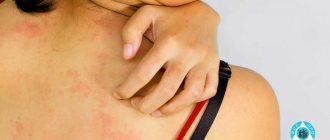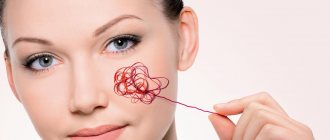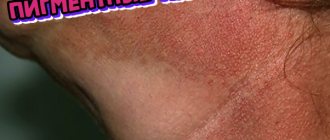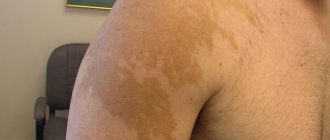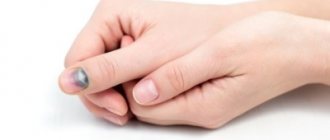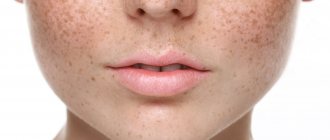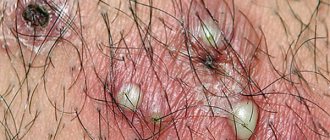An example of an armpit rash (in this case, a fungal infection called candidiasis) A skin rash affects the skin's appearance, color, or texture. The skin in the armpit area may become red, swollen, lumpy, cracked, flaky, scaly, blistered, patchy, or painful. In addition, rashes may come and go on their own or require specific treatment.
Adults (men and women) and children who are physically active, work in wet or hot conditions, or have sensitive skin types may be more likely to suffer from the rash.
Finally, it can appear in severe or mild form, in one armpit, in both armpits at the same time, or around them, affecting the upper chest or the area near the shoulder blades. Sometimes the rash can spread to other parts of the body.
Photos of rashes
To give you a visual idea of what an armpit rash may look like, here are a few images below. But it may look slightly different, depending on factors such as color, skin sensitivity, etc.
Shingles
Candidiasis – yeast fungal infection
Rash after exposure to poison ivy
Hidradenitis suppurativa – purulent inflammation in the sweat glands
Who should I contact?
If your baby develops skin rashes, it is very important to show the child to your doctor. For an initial consultation, you can contact your pediatrician. The doctor will conduct an initial clinical examination and clarify the preliminary diagnosis.
To carry out differential diagnosis, a whole range of laboratory tests and studies will be required. Treatment is prescribed only after the correct diagnosis has been established. Pediatricians provide therapy for specific childhood pathologies.
During the acute period of illness, a sick child must stay at home. Compliance with forced quarantine helps prevent mass cases of infection. It usually takes a few days for the rash to clear up.
All skin pathologies are treated by a pediatric dermatologist. Specific treatment is prescribed taking into account the cause that provoked the appearance of rashes on the abdomen. As a rule, doctors limit the duration of water hygiene procedures. Prolonged hot rashes during the acute period are usually excluded.
To treat rashes at home, various medicinal herbs are often prescribed. They should be added during bathing or for local treatment of damaged skin. Chamomile, string, sage or calendula are perfect for such a home treatment To maintain the effect, you can use this method for preventive purposes.
Evgeny Komarovsky talks about a rash on a child’s stomach in the following video.
A rash under the arms in children can be a consequence of various disorders in the body. Sometimes it indicates the development of a serious illness.
It is important to go to the hospital and see a pediatrician or dermatologist and undergo a comprehensive examination prescribed by a specialist. Based on the results of the tests, the child will be prescribed special treatment, taking into account the condition of the body and the main cause of the rash under the arms.
Causes
Effective treatment of armpit rashes requires proper diagnosis. It may vary depending on the cause of the rash.
Shaving
Removing hair, especially with an old and dull razor, can leave irritation, damage to the skin, a burning sensation, red bumps, ingrown hairs, or even allow infection to spread, leading to a rash. Some people also get rashes after epilating or plucking their hair. To prevent this problem, you can try alternatives to shaving such as waxing, laser hair removal, or using good shaving creams or using slow, short strokes to minimize damage to the skin.
Heat and sweat
Heat rash
Another common cause of skin rashes is blocked sweat glands. “Symptoms range from superficial blisters to deep red bumps” [mayoclinic.org]. It often affects children, but can also affect adults (men and women).
Increased temperature, humidity and friction in the underarm area also lead to discomfort and rashes. “The rash appears as pimples or bumps” [skincare.lovetoknow.com] and occurs when temperatures are particularly high, such as in the summer.
Such rashes go away on their own. To reduce the impact of high temperatures, you should try to wear loose, lightweight clothing during hot seasons and use calamine lotion or hydrocortisone cream to soothe irritation.
Fungal infection or candidiasis
Candidiasis (yeast infection)
The presence of Candida yeast in the armpits can lead to a fungal rash. It typically affects “almost any area of the body, but is more common in areas where areas of the skin may touch or rub against each other, such as the armpits, groin, and between the fingers and toes” [Healthline.com].
Thrush thrives in sweaty, warm, and humid environments. Additionally, hot weather, poor hygiene, and tight or synthetic clothing allow it to multiply and spread.
People who are overweight, diabetic, on antibiotic therapy, have a weak immune system such as HIV or AIDS, work in wet conditions, have an inflammatory condition or are pregnant are at increased risk of candidiasis, including axillary fungal infections.
When the disease occurs, a rash is observed, which is accompanied by itching, red-violet spots, yellow or white substances on the affected area, peeling of the skin, soreness, redness, and purulent pimples. Treatment is with antifungal drugs such as ketoconazole, clotrimazole, amphotericin B, nystatin, or antifungal lotions, ointments, and creams.
Hidradenitis suppurativa
It refers to a "skin disorder that causes abscesses and scars" [webmd.com], often affecting the anus, buttocks, groin, breasts and armpits, but can spread to the neck, back, legs or face. The cause of this condition is not entirely clear, but it is thought to be inflammation of clogged hair follicles or apocrine sweat glands.
Treatment includes corticosteroids, retinoid (vitamin A) medications, adalimumab, infliximab, cyclosporine, and laser therapy or surgery.
HIV infection
HIV skin rash
At the initial stage, the HIV virus manifests itself in the form of rashes that can affect various parts of the body, including the armpits, chest, shoulders, etc. This usually occurs within two months of infection. There are "flat or subtle rashes with small reddish dots/spots (resembling eczema) in people with fair skin and dark purple/black in people with dark skin" [dred.com].
As a rule, such a rash does not itch and disappears within three weeks. However, for relief, you can try hydrocortisone cream or Benadryl to reduce itching, avoid hot showers or baths, and direct sunlight.
Deodorants and antiperspirants
Deodorant Rash
A rash can occur if you are allergic to some of the ingredients in your deodorant or antiperspirant. The skin is often “itchy, bumpy and red, and may peel, peel, or blister” [allergies.about.com].
To avoid this, you need to replace your deodorant or antiperspirant and use hypoallergenic brands for sensitive skin.
Contact dermatitis
Contact dermatitis under the arm
Allergic reactions to various chemicals such as soaps, shaving creams, body lotions, cosmetics, synthetic clothing materials, fragrances or detergents can cause rashes that are often red and itchy. They develop when the skin of the armpits comes into contact with allergens.
Lymphoma
Lymphoma can sometimes cause "an itchy rash... in the folds of the skin" [healthline.com], and the armpits are no exception. May be accompanied by lymphedema or inflammation of the lymph nodes.
Ringworm
Ringworm
Ringworm, or shingles, “causes scaly, crusty rashes that may appear as round, red spots on the skin” [medicinenet.com]. Hair loss, flaking, itching, blisters and other symptoms may also occur.
Staphylococcal infection
Staphylococcus is a bacterium resistant to methicillin and beta-lactam antibiotics. There are two types of methicillin-resistant Staphylococcus aureus: common (CS-MRSA) associated with poor hygiene, contact with contaminated items, and hospital-acquired (ha-MRSA) associated with surgical procedures, intravenous catheters, etc.
The first type often affects scratched, damaged or chafed areas of the skin, as well as areas with a lot of hair, such as the “buttocks, armpits, back of the head and chin” [healthline.com]. Infected areas become swollen, fluid-filled, red, and painful.
Treated with antibiotics and drainage. It is necessary to observe the rules of personal hygiene and avoid sharing personal items (towels, razors, sports equipment), take a shower after sporting events, disinfect linen, regularly wash your hands, etc.
Other reasons
In addition to the above, armpit rashes can be caused by several causes or factors, which include shingles, folliculitis, diabetes (makes people susceptible to fungal infection), pregnancy (most women are vulnerable to fungal infections during this period), granuloma annulare and poor personal hygiene.
There are also other possible causes of rashes such as excessive sweating, dermatitis, ichthyosis, bites, eczema, impetigo, Lyme disease, pityriasis rosea, Kawasaki disease, psoriasis, acne, cellulitis, urticaria and many others.
What does it look like?
Skin rashes can manifest in different ways. This largely depends on the cause that led to the development of these rashes.
For allergies
Allergic skin elements look like bright red individual spots. They can be located in various parts of the body. Typically, these elements are very itchy and bring severe discomfort to the sick baby.
The duration of allergic rashes remaining on the skin may vary. Usually, unfavorable symptoms persist as long as the allergen remains in the child’s body.
If a child receives specific treatment, but the substance that provokes the allergic reaction continues to enter, then a rash may remain on the skin for quite a long time. New bulk elements that have appeared recently will generally have a more intense color.
You can distinguish allergic rashes from other skin manifestations at home. In this case , when you press on a separate element of the rash, it turns pale and usually disappears.
The presence of various types of allergies in close relatives also greatly facilitates differential diagnosis. In this case, the appearance of a rash on the baby's skin may be caused by genetic allergic sensitivity to a specific allergen.
Dermatitis, which is allergic in nature, usually appears in areas with thin areas of skin. The appearance of such rashes on the abdomen is a fairly common location. The spread of bright red elements over all skin also confirms that the child has a possible allergy.
To eliminate unfavorable symptoms in this case, doctors prescribe antihistamines that have a pronounced anti-inflammatory and antisensitizing effect.
For prickly heat
Miliaria on the skin of a child is manifested by the appearance of multiple red and white spots. In some cases, they can also be located on the stomach. This is especially common when using excessively warm clothes in the hot summer.
Rash with itching
Psoriasis is an overgrowth of “extra” skin cells that is accompanied by itching.
Itchy rashes can occur with ringworm, psoriasis, eczema, lymphoma (a type of cancer that affects the lymph nodes), contact dermatitis, deodorant allergies, HIV infection, fungal infections, folliculitis, and others.
To deal with this problem, it is necessary to treat the underlying cause. You can also try various tips and home remedies to help soothe the itching, including applying fruit paste, fresh basil leaves, or peppermint leaves. Apple cider vinegar, aloe vera, clay and oatmeal or flour may also help
Finally, you should avoid the temptation to scratch your armpits, even if there is a burning sensation, you can try cold compresses, cold baths, anti-inflammatory drugs, antihistamines, creams and ointments containing menthol, phenol, camphor, pramoxine, diphenhydramine, benzocaine, etc., and also hydrocortisone.
Preventive recommendations
Following certain rules will avoid irritation on the skin of the armpits and relieve the feeling of discomfort. To do this you should:
- Prefer to wear loose-fitting clothes made from natural fabrics;
- Wash the skin of your armpits with water at least once a day;
- When shaving in this area, it is important to properly prepare the skin and carry out the procedure using special gels;
- After shaving, treat the skin against possible penetration of bacteria.
If your skin is sensitive to many components in washing powders or shower gels, you need to choose those that do not cause an allergic reaction. If internal changes are the cause of irritation, you must immediately consult a doctor and eliminate the provoking factors.
You should not wear clothes that fit closely to the skin. You should not wear synthetic fabrics, give preference to natural clothes. It is necessary to wash twice a day, as pathogenic bacteria develop in sweat.
Do not apply deodorant immediately after shaving. Before applying antiperspirant after a shower, you need to let the skin dry completely. In case of skin injuries, you need to treat the damage with an antiseptic. It is better to trim long hair before shaving.
Rash with redness
Disseminated granuloma annulare due to diabetes
In addition to itching, the rash may also be accompanied by redness (deep red to brownish red). A burning sensation, pain, lumpiness, and clear or yellow discharge may be present. These symptoms may spread to other parts of the body, such as the buttocks or groin.
Some of the most common causes include shaving, fungal infection, candidiasis, folliculitis, HIV, use of certain deodorants, contact dermatitis, disseminated granuloma annulare, lymphoma, cellulitis, lichen, eczema, urticaria and others.
Painful rashes
The pain can be dull, sharp or sharp, and the rash can be red, itchy, bumpy, etc. Hidradenitis suppurativa, staphylococcal infection, lichen, cellulitis, urticaria, eczema, folliculitis, some allergic reactions and other diseases can provoke pain rashes in the armpit area.
You can try various home remedies for relief. In addition, various creams or medications can help cope with painful sensations. You should consult your doctor for treatment recommendations.
Diagnostic measures
A specialized specialist will help you determine the root cause and make the correct diagnosis. It is impossible to independently determine the source of the violations; it is strictly forbidden to give children medications without a doctor’s prescription.
A pediatrician or dermatologist examines the patient and, if necessary, prescribes additional tests:
| Name | Description |
| Scraping | For laboratory tests, tissue is taken from the affected area of the body and examined under a microscope. |
| General and biochemical blood test | Tests allow you to determine viral or bacterial damage to the child’s body, identify the inflammatory process and other disorders. |
| Skin tests for allergies | Specialists use various solutions to determine the source of the allergic reaction. |
Diagnostic measures will help the doctor establish an accurate diagnosis and, based on the information received, select the most effective treatment regimen. It is important to differentiate the provoking disease, since many serious pathologies are accompanied by similar clinical signs.
Treatment
Antiviral medications are used to treat underarm rashes caused by viruses; bacterial infections will require antibiotics, while rashes caused by fungi require antifungal medications. To help relieve some of the symptoms, you can try home remedies, anti-inflammatory medications, antihistamines (if allergy-related), and other medications.
Home Remedies
- Ice – applied in the form of ice packs (or ice cubes wrapped in a clean cloth) to relieve itching
- Vitamin E, aloe vera and tea tree oil. Apply vitamin E, tea tree and aloe vera oil to soothe and reduce inflammation.
- Vitamin C – increase intake to reduce skin infections
- Lemon – Rub over the underarm area to help kill bacteria. Also acts as a natural deodorant. Do not use immediately after shaving.
- Diluted tea tree oil - used to kill fungus and relieve itching
- Baking soda – Add about half a teaspoon to bathing water or underarms to help dry out skin.
Other helpful remedies include a mixture of lavender and coconut oil (helps with irritation and breakouts), crushed fresh strawberries and cream (soothes irritation), and neem leaf paste (has antiseptic and antibacterial properties).
Cream
Antifungal creams should be used whenever the cause of the rash is a fungal infection and antibiotic ointments when the cause is a bacterial infection.
Some of the creams, such as hydrocortisone, Benadryl, Calamine lotion, are good for soothing the skin after mild irritation (itching, discomfort or pain).
Hormonal changes
All metabolic processes that occur in the human body are directly or indirectly controlled by hormones. The intensive restructuring of these processes, which occurs during puberty, pregnancy, or the onset of menopause, is accompanied by significant hormonal changes. A concomitant symptom may be itching in the armpits. Moreover, most often these unpleasant symptoms are caused by menopause.
There are situations when the symptom in question is not a natural reaction of the body to the action of an external stimulus or to a change in some internal process, but a manifestation of pathology. The treatment and management tactics of the patient will depend on what caused the itching of the skin of the axillary fossa.
General Tips
- Maintain good personal hygiene and thoroughly clean the affected areas (use mild soap at least twice a day).
- Wear clothes made from natural fibers.
- Cornstarch may help dry out rashes
- Place a soft piece of tissue under the armpit to reduce friction.
- For a quick recovery, stop using deodorants, antiperspirants, perfumes, body creams or lotions.
- It is good to ventilate the room, especially if the rash occurs during warm periods of time.
- Use special anti-friction powders.
Home remedy recipes and instructions for use
A rash under the arms of a child can be treated with prescriptions from witch doctors and healers, if there are no serious contraindications. Their use should be discussed with a pediatrician or dermatologist. The components used may cause an allergic reaction or other complications.
Effective traditional medicine recipes:
| Name | Recipe | Application |
| St. John's wort | Brew 3 tbsp. dry herbs with hot water (400-500 ml). Leave for 1-2 hours and strain. | The resulting decoction is recommended for use as compresses. Wet a cotton swab and apply it to the affected area of the body. It is recommended to carry out the procedures 3-5 times a day. |
| Herbal collection | Mix chamomile sage and peppermint in equal parts, 3 tbsp each. Pour boiling water (1 liter) over the resulting mixture. Put on fire and heat for another 10-15 minutes. Then cool and strain. | The herbal decoction is recommended for use in baths, lotions and washing the armpits. |
| Soda | Pour 2 tbsp. soda with warm water (200 ml). | The resulting solution is used to treat the affected areas of the child’s body. It is recommended to carry out the procedures at least 5 times a day. After baking soda, you can apply a moisturizer to your skin to help it recover faster. |
| Series | Pour 5 tbsp. herbs with hot water (1 l). Leave for 30 minutes and strain. | The resulting decoction is added to the bath while bathing. The series fights well against irritation, itching, and redness. |
| Starch | Dilute 90 g of product in 1 tbsp. warm water, mix well. | The resulting solution is poured into the bathroom. They bathe for 30 minutes and leave the bath without drying themselves with a towel. |
Ice will help relieve itching. Small pieces are wrapped in cloth and applied to the affected areas of the body. Oily vitamin E helps eliminate irritation and inflammation.
Lack of timely treatment will lead to complications. The child will itch, damage the blisters and cause an infection. There is also a high probability of scar formation. The entry of infection into the blood provokes the development of sepsis, and the functioning of internal organs is disrupted.
Additionally, complex therapy for rashes in the armpits in children involves preparing a special diet for the little patient. It is important to exclude from the menu all foods that increase the likelihood of an allergic reaction.
| Authorized Products | Prohibited Products |
|
|
Drinking enough fluids will help remove toxins from the body and eliminate the accompanying symptoms of the pathological condition.
In most cases, armpit rashes in children are the result of failure to follow simple hygiene rules. Parents dress the child too warmly, he sweats, which also provokes an inflammatory process. You should contact your pediatrician to rule out the possibility of developing a serious illness. Because progressive pathological processes will lead to dangerous complications.
